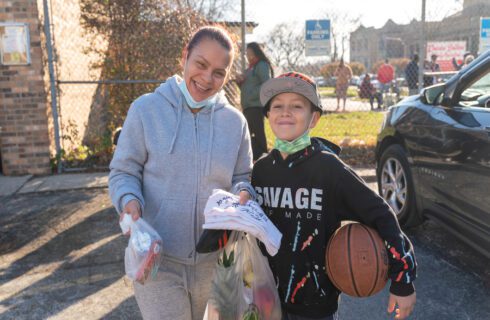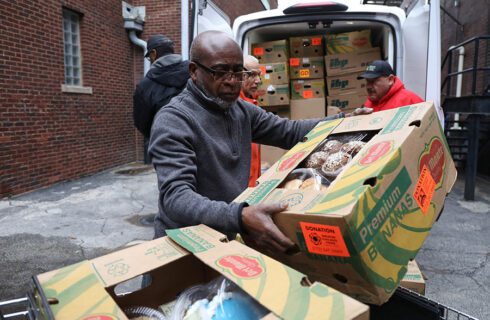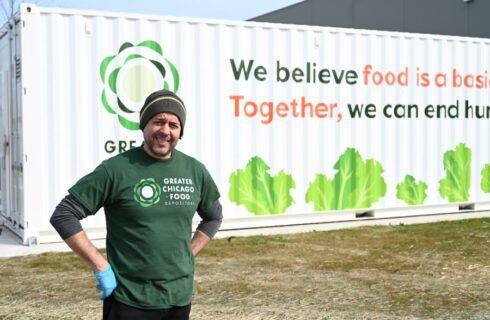When the pandemic disrupted society last March, millions of Americans who were thrust into economic uncertainty scrambled for needed food assistance.
In the early weeks of April that followed, the Illinois Department of Human Services, which administers the federal Supplemental Nutrition Assistance Program (SNAP) in this state, was processing up to 35,000 applications for SNAP benefits a week – more than three times the usual weekly average.
Calls to the Food Depository’s benefits hotline also grew exponentially. The Food Depository’s policy team, working in tandem with our benefits outreach team, worked hard to communicate important changes to federal nutrition programs and help connect people to needed assistance.
“Our work changed drastically just as the need changed drastically,” said Colleen Burns, the Food Depository’s state engagement and innovation lead. “In those first few months of the pandemic, our applications for SNAP just absolutely soared.”
Burns, 37, has brought considerable knowledge and experience to the challenge since joining the Food Depository last March, just prior to the stay-at-home order. A healthcare attorney, she worked for the state Department of Insurance right out of law school to help establish the new health insurance marketplace authorized by the Affordable Care Act. She also worked for Gov. Pat Quinn’s office for a year before leaving to work as a subcontractor for the federal government to enforce the healthcare law.
As the Food Depository’s liaison to state agencies, Burns was instrumental in the crafting of the Illinois Commission to End Hunger’s new report, “From Food Insecurity to Food Equity: A Roadmap to End Hunger in Illinois,” which was released in March.
A native South Sider, Burns grew up in a family that discussed politics and social justice around the dinner table. The daughter of a nurse-turned-artist and a union lawyer, Burns now lives in suburban Oak Park with her husband, John Korpics, and their four children.
The following interview has been edited for length and clarity.
There have been so many policy and program changes during the pandemic. Looking back on this past year, what have been some of the largest policy successes at the federal level?
The federal government, in the stimulus package that passed in December, included a 15 percent increase in SNAP benefits overall, that would increase the amount an individual would receive per month. It was about $28 for a single person, more than $100 for a family of four. Congress acted again this spring to extend that increase in benefits through the end of September of 2021.
It’s hard to overstate how important that boost in benefits is to households. (Editor’s note: In February 2020 before the COVID-19 pandemic, the average monthly benefit per person was $121.13, or just a meager $1.35 per person per meal.) That 15 percent increase in benefits across the board is absolutely pivotal to making sure that individuals and households are able to meet their nutrition needs for the month.
What about the Pandemic EBT program? That seems to be a program that’s helped many families in need.
Pandemic EBT, which replaces the value of school meals for children who are not in school, is really a great example of a huge success. During the early months of the pandemic, food insecurity doubled for the population overall but tripled among households with children. The Greater Chicago Food Depository worked very hard to promote it. It’s a hugely important program. We created, for example, a set of frequently asked questions in six different languages – English, Spanish, Polish, Mandarin, Arabic and Urdu – and then distributed it to community-based organizations all over the state, so we could reach as many people as possible.
The Department of Human Services sent out about 806,000 P-EBT cards in March and in April they were planning to get out an additional 162,000. When I talked to them last week, they were at 969,000 kids. That’s incredible.
(Editor’s note: The state is currently putting together a plan to expand the program to children age 5 and under, extending these important benefits to even more families with children.)
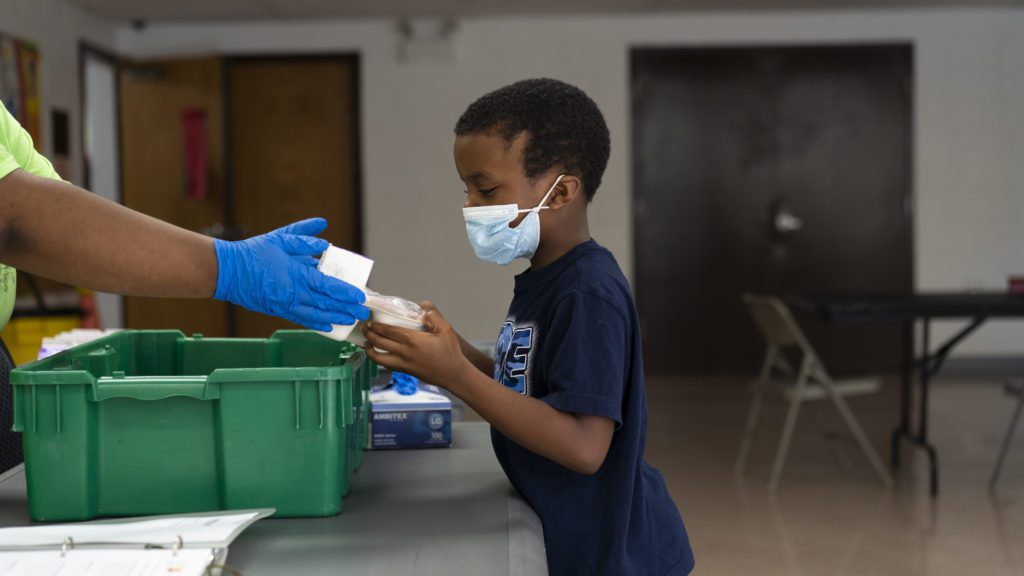
Students at remote learning support sites, like the South Side YMCA (pictured here), receive free meals they would have otherwise been served at school. The Pandemic EBT program will also provide students' families with additional food assistance. (Photo by Mateo Zapata for the Food Depository)
The Illinois Commission to End Hunger recently released its Roadmap to End Hunger. What are some key takeaways from that plan that could really help move the needle?
In the long run, ending hunger is going to require that we address the root causes of poverty and racial inequity. And any solution to food insecurity must also include strategies that include equitable economic outcomes.
The report, “From Food Insecurity to Food Equity: A Roadmap to End Hunger,” acknowledges that in the short term, Illinois can make meaningful progress against hunger by better connecting people to food programs and promoting equitable access to food. And the report highlights three strategies to do that – working collaboratively across state agencies and community-based organizations to better connect people to programs, leveraging technology to connect people to those benefits and harnessing innovation to help programs to reach more people.
What are some of the barriers in terms of people connecting to benefits?
It varies by population. Some people may not even know that the programs are out there, who is eligible, or how to apply. Among immigrant and mixed status households, there’s also hesitancy to enroll in programs. They’re often fearful, frankly, of accessing public benefits for fear of it having implications for their immigration status. We know that kids are at higher risk of food insecurity, as are older adults, people with disabilities and people experiencing homelessness.
We need to do a better job of promoting our federal nutrition programs and making sure people understand how to enroll and how to stay enrolled. And we need to communicate those messages in a way that is culturally competent.
How can technology help connect people to the resources they need?
Technology plays an important part in all of our lives. The Illinois Commission to End Hunger conducted statewide listening sessions for the latter part of last year. We learned that a lot of people do not have access to a desktop computer in their home, but a large majority of people do have access to a smart phone.
One of the things that the Illinois Commission to End Hunger report lifts up is that we could pursue a mobile friendly version of the SNAP application. For those who don’t have access to a computer, they could go through the application process on their phone.
And that possibility comes at a time when people are increasingly able to use their SNAP benefits online to buy groceries, right?
Yes, that happened during the pandemic. Illinois was approved to operate SNAP online so SNAP households can use their benefits for online grocery delivery. Currently, there are three retail chains throughout the state that are in that program: Aldi, Amazon, and Walmart. We are working to encourage others to come on board, including small and midsize retailers that face unique barriers to entry. At a time when people are trying to maintain social distancing, SNAP online is an important part of making sure we’re keeping our federal nutrition programs flexible and safe during the pandemic.
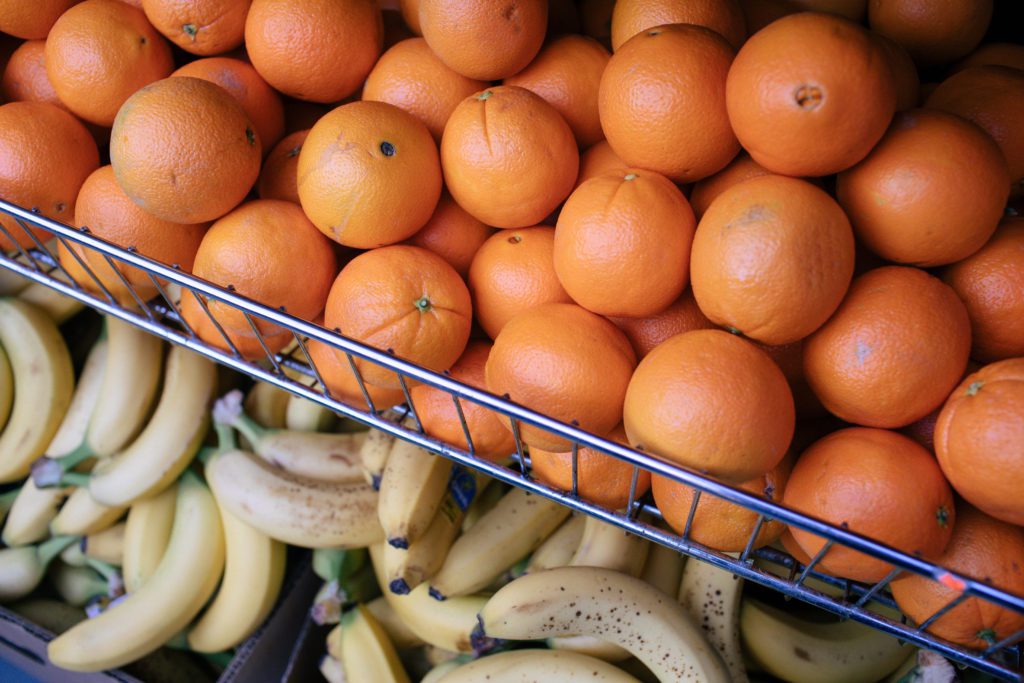
Boosts and additional flexibilities in the Supplemental Nutrition Assistance Program help families better afford nutritious food, including fresh produce.
At this moment, after one year of the pandemic, how are you feeling right now?
I’m very optimistic because we have the federal nutrition programs and the infrastructure in place to connect people to those programs. We have dedicated state agency partners and amazing community-based organizations all over our state that are doing this work every single day. Now is the time for us to find innovative ways of collaborating with organizations, create new strategic partnerships and ultimately serve our clients better.
But the infrastructure is in place. Our federal nutrition programs were there when we needed them.
Share This Post


